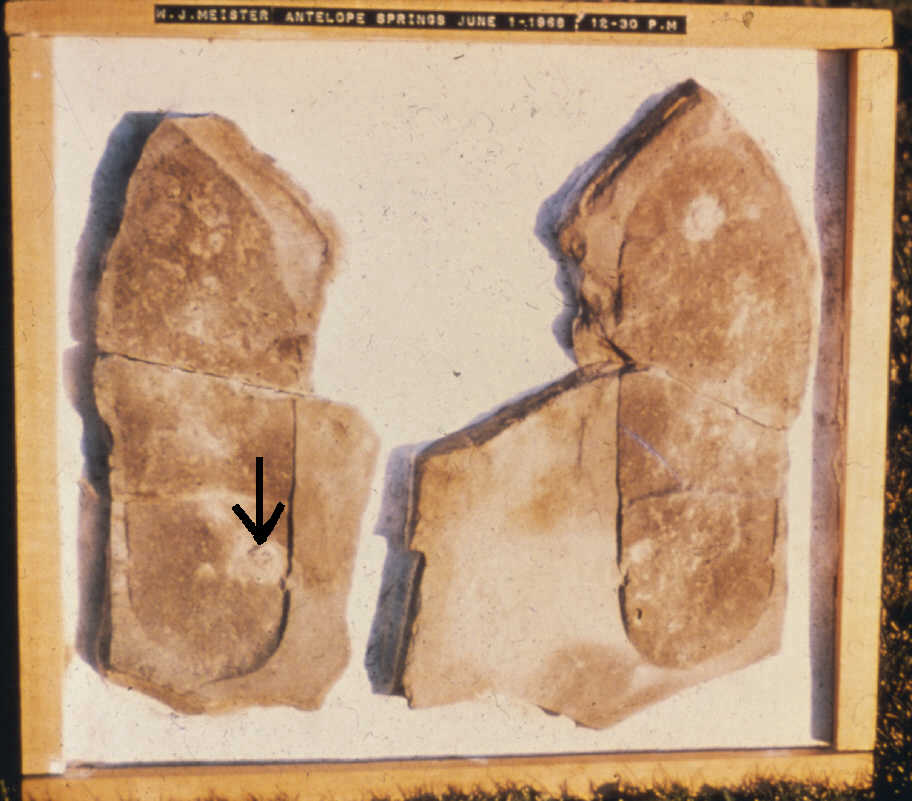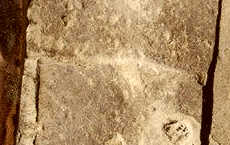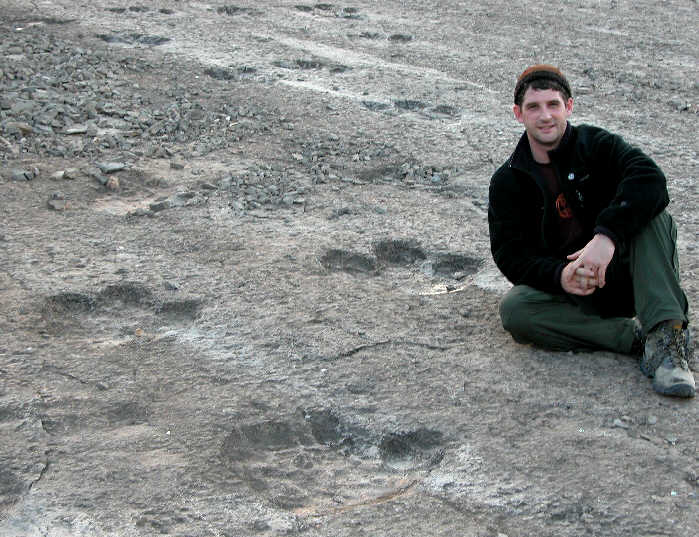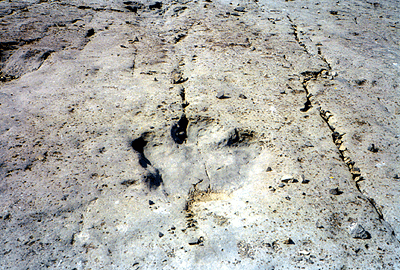YECs often assert that human footprints can be found in strata that geologists state were deposited hundreds of millions of years ago, well before humans first appeared in the fossil record. From this they assert that mainstream geology is wrong, the Earth is young, and these footprints were made around the time of a global flood. This is once again another example of YEC distortion of the evidence. Invariably, the footprints are either geological artefacts, or footprints of other animals that have been misinterpreted as human by YECs.
The compiler of SEfaGF never provides any references for his blithe assertion that:
Human palaeontological evidence exists even in the earliest geologic 'ages' (ex. human footprints in Cambrian, Carboniferous, and Cretaceous rocks). If the layers of rock were laid down by a global flood and then interpreted as evolutionary long-ages, human remains and artefacts would appear to be in such positions.
It does not take much research to find the examples about which SEfaGF is speaking. The alleged human footprint in the Cambrian quite likely refers to the discovery in 1968 by William Meister, an amateur geologist, of two trilobite fossils in what YECs claimed was a sandal print. The alleged human footprint was found in the middle Cambrian Wheeler Formation in Utah, which is over 500 million years old. Unsurprisingly, it was quickly touted by special creationists as something that had the potential to overturn the entire geological column, given that anatomically modern humans are found no earlier than 200,000 years ago.
 |
| The "Meister Print". Photo provided by Clifford Burdick, 1982. Arrow points to one of the trilobites in the specimen. |
 |
| Close-up of the "heel" line of the specimen, showing the crack line extending beyond the indentation on the left side of the specimen. |
Unsurprisingly, the Meister footprint was quickly exploited by YECs, who were characteristically less than rigorous in their investigation of the credibility of this claim. Science teacher Ernest Conrad, present at a 1973 debate featuring Duane Gish and a Reverend Boswell (a local church cleric) notes:
During the question-and-answer period of the Sacramento debate, I asked Reverend Boswell what scientific evidence he had and what institutions established that the bootprint was real. He answered, "It was the University of Utah and U.C.L.A. and I have forgotten the third. These two are fairly academic institutions. They are familiar with the specimens."
Following his lead, I wrote to the Utah Museum of Natural History at the University of Utah—a "fairly academic institution." I received a letter in return which said:
The "footprint" in question was collected by a man named Meister several years ago, and it was immediately jumped on by Melvin Cook, who is not a paleontologist, as evidence of human-trilobite cohabitation.
I have seen the specimen in question and it is nothing more than a slab of Wheeler shale that has a fragment spalled off in the form of a footprint, which reveals a trilobite, Erathia kingi.
To reiterate, the trilobite is genuine, the footprint is not.I was referred to an article by Professor William Stokes of the Department of Geological Sciences. Dr. Stokes wrote:
I unhesitatingly assert that this is not a footprint. I have observed and collected a number of types of footprints that meet all the critical requirements, and I have had no qualms about describing these in print even though some were totally new. The Meister specimen is the result of a natural break, which happens to resemble a footprint. This type of fracture is called spalling and the part which breaks out or is detached is called a spall.
The specimen was in no sense faked, and I am sure it was found exactly as reported. But I, along with my geologist friends, are equally sincere in my belief that it is an accidental natural product and not a footprint.
One might think a difference of opinion such as this could be solved by appeal to impartial judges or by a more thorough investigation of the field of evidence. But from the time of discovery, the specimen has taken on a religious significance that makes a friendly solution almost impossible.I did not contact the other "fairly academic institution," U.C.L.A, because I could see, by studying the creationist photograph of the alleged "bootprint," that it resembled a print only superficially, much as the "Man in the Mountain" in New Hampshire superficially resembles a human face. The sides of the print are unnaturally angular, and the whole print is unnaturally shallow. Cook even notes the shallowness, saying, "The heel print was indented in the rock about an eighth of an inch more than the sole." This doesn't make for a very pronounced heel. Calling it a "sandal print," as Kofahl and Segraves do, seems to excuse the heel, but, taken as a whole, Meister's discovery is one of the most superficial-looking "human footprints" that I have seen in creationist literature. [1]
While the trilobite fossils are real, the footprint (unsurprisingly) is not, as it is simply a geological artefact. As Glenn Kuban notes:
The specimen does contain at least two real trilobites (which are abundant in the outcrops around Antelope Springs), but the supposed sandal print does not stand up to close scrutiny. The overall shape is seen to consist of a spall pattern in a concretion-like slab, similar to many others in the area. There is no evidence that it was ever part of a striding sequence, nor that it was ever on an exposed bedding plane, as real prints would be. The "print" is very shallow and shows no sign of pressure deformation or foot movement at its margin. However, on one side of the print, extending to the side of the supposed toe end is a rim or lip that is typical of similar concretions from the area, but which is incompatible in position and form to be a pressure ridge. Also, of the two halves of rock, the side that has the heel indented shows raised relief at the toe end, and vice versa, whereas in a real print one should show impression or raised relief throughout each half.
The supposed "heel" demarcation is actually a crack that runs beyond the boundary of the supposed print. It is best seen on the far left side as one views the print in the photograph herein. The slight relief difference at this point is due to slight movement along the crack line (Conrad, 1981 ; Stokes, 1986).
Similar concretionary shapes and spall patterns are abundant in the Wheeler formation, as are slabs showing concentric oval shapes of varying color, sometimes with stair-step like relief. Several other of these oblong features have also been interpreted as possible human prints (Cook, 1970), but are even less convincing than the Meister specimen (Conrad, 1981). None occur in striding trails or otherwise meet the scientific criteria by which genuine human prints are reliably identified. The geochemical processes such as solution penetrations, spalling, and weathering which form such features in fissile rocks of the Wheeler formation was discussed in considerable detail by Stokes (1986).
Several such "pseudo-prints" from Antelope Springs were sent to me in the early 1980's by creationist biologist Ernest Booth. One showed both an ovoid spall pattern similar to the Meister print, and another a color-distinct ovoid pattern without topographic relief. Booth expressed dismay that fellow creationists had not explained that such superficially print-like features were abundant at the site, and were products of geological phenomena and not real prints (Booth, 1982).
Some creationists have noted that the find was "confirmed" by "Dr. Cook." However, Dr. Cook was a metallurgist with little paleontological experience or knowledge. In his own report on the find Cook states, "...I am by no means an authority on fossils and footprints." He adds that the print seems to "speak for itself". However, upon careful inspection the evidence does not support Cook's conclusions.
In short, the trilobites in the specimen are real enough, but the "print" itself appears to be due solely to inorganic, geologic phenomena. After mainstream rebuttals of this find were published in the 1980's (Conrad, 1981; Stokes, 1986; Strahler, 1987), only a few creationists continued to suggest this was a real print, while most former advocates of the specimen have quietly abandoned the case. [2]
Creationist claims of human and dinosaur footprints being found in the same strata have repeatedly been debunked. The best known examples are the Paluxy River footprints near Glen Rose, Texas. The dinosaur footprints are real, but the “human footprints” are either forgeries, or misinterpretations:
For many years claims were made by strict creationists that human footprints or "giant man tracks" occur alongside fossilized dinosaur tracks in the limestone beds of the Paluxy River, near Glen Rose Texas. If true, such a finding would dramatically contradict the conventional geologic timetable, which holds that humans did not appear on earth until over 60 million years after the dinosaurs became extinct. However, the "man track" claims have not stood up to close scientific scrutiny, and in recent years have been abandoned even by most creationists. The supposed human tracks have involved a variety of phenomena, including forms of elongate, metatarsal dinosaur tracks, erosional features, indistinct markings of uncertain origin, and a smaller number of doctored and carved specimens (most of the latter occurring on loose blocks of rock). A few individuals continue to promote the Paluxy "man tracks" or alleged human tracks in pre-Tertiary rocks from other localities, but such claims are not considered credible by either mainstream scientists or major creationist groups. [3]
The special creationist geophysicist Sergei Golovin claimed [4] that human footprints were found alongside dinosaur footprints in Turkmenistan. The original announcement he states was made in the English version of Moscow News in 1983, and later reported in the 31st January 1995 edition of Komsomolskaya Pravda. Tellingly, one does not see in the AiG article any reference to independent scientific confirmation of this discovery, or any references to the mainstream palaeontological literature where such claims would be reported.
It is interesting however to note that Glen Kuban has also examined this dubious story of Russian (actually, Turkmen) human / dinosaur footprints in the same era, and as one would expect, the claims are entirely without merit:
This alone casts enough doubt on the claim for a reasonable person to conclude that the creationist allegation can be set aside as unproven. Kuban continues by noting that the Turkmenistan tracks have been studied in the mid-1990s by a team of American scientists. [6] The dinosaur tracks are real, and have been dated to the late Jurassic:
The authors don’t refer to any human-like tracks in their paper, but they do refer to elongated, long-heeled prints up to 70cm in length. Kuban notes that such tracks, particularly if they are blurred or filled-in can be mistaken for human prints. [7] One would imagine though that prints 70cm in length, are hardly likely to be confused with human prints. What of the alleged human footprint? Kuban notes:
It is interesting however to note that Glen Kuban has also examined this dubious story of Russian (actually, Turkmen) human / dinosaur footprints in the same era, and as one would expect, the claims are entirely without merit:
A 1996 Creation magazine article by Russian geophysicist Sergei Golovin, reproduced as an AIG website article, reported that the 31 January 1995 edition of the Russian newspaper Komsomolskaya Pravda stated, "Human footprints lie alongside thousands of dinosaur prints on a Turkmenian plateau." The author of the article, journalist Alexander Bushev, reportedly traveled to the tracksite near the village of Khodja-Pil Ata in Turkmenistan, and had seen the fossilized prints of dinosaurs and humans together. According to Golovin, who has not personally visited the site (Golovin, 2006), Bushev indicated that the half-kilometer wide rock bed contained over 3000 three-toed dinosaur tracks, considered by Turkmenian scientist Kurban Amanniyazov to be at least 200 million years old (which would place them near the boundary between the Triassic and Jurassic periods). Golovin's article quoted Bushev as stating 'But the most mysterious fact is that among the footprints of dinosaurs, footprints of bare human feet were found!'
Despite these claims, Golovin's article did not include any photos or scientifically rigorous descriptions of the alleged human tracks, in terms of their specific size, clarity, shape and contour details, or stride patterns. Nor have any of the other creationist authors who repeat or encourage the human track claims.
Amanniyazov himself authored a scientific paper describing the Turkmenistan Tracks, noting that there were a number of track sites in the area, with the main site contained 35 recognizable trackways, involving 1365 individual traces. These he attributed to three different types of bipedal dinosaurs, and indicated that the track beds were late Jurassic, not late Triassic (about 50 million years younger than earlier reported). Curiously, no mention is made of human like tracks until the end of the paper, where (based on the English translation), Amanniyazov writes, "One more thing should be pointed. It's track that has a resemblance of a print of some human being. It is not clear, but is easy for distinguishing. There are not enough scientific reasons yet to confirm that its a human being's, but the investigations are still going on" (Amanniyazov, 1985). If the translation is reasonably accurate, this appears to imply that unlike earlier reports referring to multiple "human tracks" or clear human tracks, there was only one indistinct human-like track. The meaning of "easy for distinguishing" is uncertain--since the human track was already called "not clear" perhaps the author simply meant that it was unlike the nearby types of dinosaur tracks. However, he did not include a photograph of the print in question, nor indicated where on the site it was located, or even if it is on the main site. Thus, it remains uncertain as to exactly what Amanniyazov had seen. [5] (Emphasis mine)
Turkmenistan dinosaur trails. Photo courtesy of Stantours.com.
Turkmenistan dinosaur track shown at www.stantours.com website.
This alone casts enough doubt on the claim for a reasonable person to conclude that the creationist allegation can be set aside as unproven. Kuban continues by noting that the Turkmenistan tracks have been studied in the mid-1990s by a team of American scientists. [6] The dinosaur tracks are real, and have been dated to the late Jurassic:
The largest site in Turkmenistan, Kodhja-Pil-Ata, reveals the longest dinosaur trackways recorded anywhere in the world so far (five trackway segments that measure between 184 and 311 meters). The late Jurassic sites, as well as other localities in adjacent Tadjikistan probably formed part of a huge megatracksite covering several thousands of square kilometres. All of them are associated with the northern Tethyan costal belt.
The authors don’t refer to any human-like tracks in their paper, but they do refer to elongated, long-heeled prints up to 70cm in length. Kuban notes that such tracks, particularly if they are blurred or filled-in can be mistaken for human prints. [7] One would imagine though that prints 70cm in length, are hardly likely to be confused with human prints. What of the alleged human footprint? Kuban notes:
Until 2007, the only track photograph I was able to locate in connection with this site that is even remotely humanlike in shape was shown in an article about the Turkmenistan prints on a website (removed in 2007) by strict creationist Jeff Brenner (Brenner, 2006). The article did not indicate the source of the photo, or even clarify whether it is from the Turkmenistan site. The photo did not show a clear human track, but rather an elongate depression with what appears to be significant anterior splaying and more of a three-toed than 5-toed human pattern at the front. There is no discernible ball-arch-heel pattern on the print bottom, and overall, it appears at least as compatible with a metatarsal dinosaur print as a human print. Unfortunately, if it is the former, the far anterior end which might show more indications of a dinosaurian digit pattern is probably cut out of the picture.
Track shown at Jeff Brenner's website. Presumable from the Turkmenistan site. Source
Kuban’s concluding paragraph should settle the question of whether the Turkmenistan prints are human:
In view of the fact that elongate dinosaur tracks and other non-human phenomena that have been mistaken for human footprints in the past, (Kuban) the lack of rigorous documentation by the human track advocates, Golovin's suggestion that the those who do not accept the human track claims suffer from "evolutionary indoctrination" rings hollow. Likewise, when Benner suggests that the human track claims seem convincing simply because evolutionists have not disproved them, he seems to misunderstand the nature of science. When extraordinary claims are made, the burden is on the claimants to back them up. Without rigorous documentation of the alleged human tracks, what does Benner expect the scientists to address? They've described and documented the dinosaur tracks, and so far the humanoid track proponents have presented no substantial evidence that human or even very human-like tracks occur at the site. Indeed, even major creationists groups have refrained from endorsing the claims. For example, "Answers in Genesis" tempered Golovin's remarks by noting that "one needs to be cautious about accepting the prints described on the basis of just this report. None of our sources has been able to obtain any further information on the prints, nor any photographs to this date."Conclusion
The claim that human footprints exist in ancient geological strata is false. Either the footprints are geological artefacts, or they are footprints of other animals that have been misinterpreted. Yet another alleged claim for a global flood has been shown to be false.
References
1. Conrad E “Tripping over a Trilobite: A Study of the Meister Tracks” Creation / Evolution (1981) 2:30-33
2. Kuban G “The ‘Meister Print’: An Alleged Human Sandal Print from Utah”
3. Kuban G.J. The Texas Dinosaur / “Man Track” Controversy. The Talk Origins Archive.
4. Creation (1996) 18:52. It was later republished on the Answers in Genesis website.
5. Kuban G.J. A Russian “Paluxy?”
6. Meyer, C. A. and Lockley, M. G., 1997, Jurassic and Cretaceous dinosaur tracksites from central Asia (Usbekistan and Turkmenistan) Journal of the Paleontological Society of Korea, p. 43-65.
7. Kuban, G.J. 1986 “Elongate Dinosaur Tracks” In Gillette, David D. and Martin G. Lockley, eds., Dinosaur Tracks and Traces, (1989, Cambridge University Press, Cambridge) pp. 57-72


